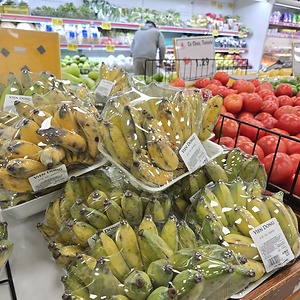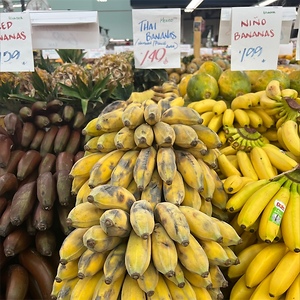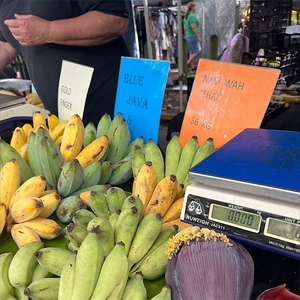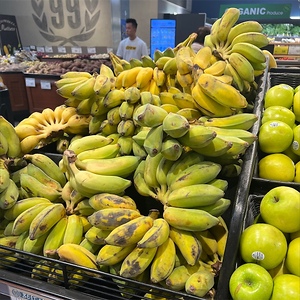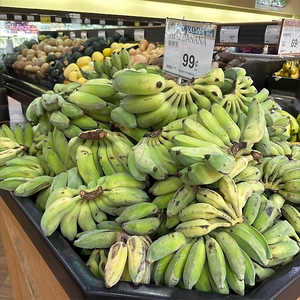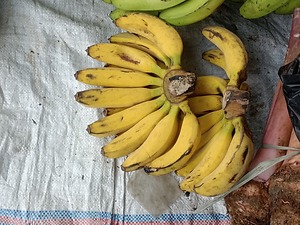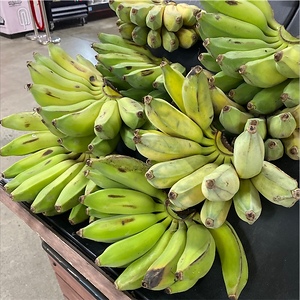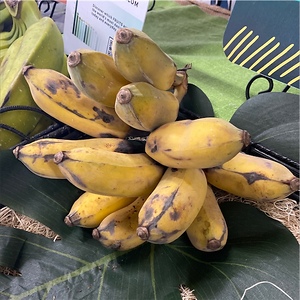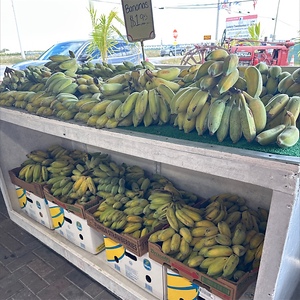

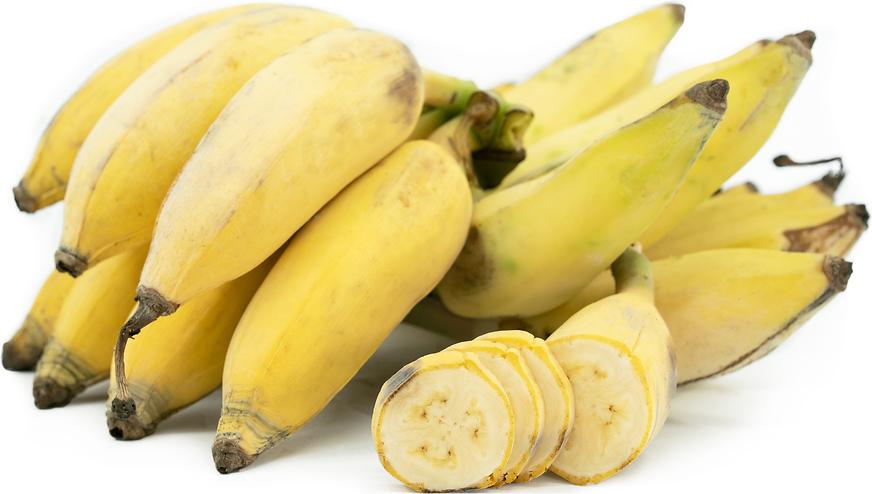
Nam Wah (Thai) Bananas
Estimated Inventory, lb : 0
This item was last sold on : 11/22/23
Description/Taste
Nam Wah bananas are generally small to medium in size, averaging 12 to 15 centimeters in length and 4 to 5 centimeters in diameter, and have a straight to slightly curved shape. Each banana has an angular nature with two narrow faces and two broad, flat faces, separated by defined edges. The fruits taper at both ends, and the peel is smooth, rubbery, thin, striated, and taut. Nam Wah bananas are ripened from green to golden yellow hues, and the peel is delicate and easily bruised. With maturity, the peel may also develop dark brown spots and marks, almost appearing black. Underneath the peel, the cream-colored or ivory flesh is firm and starchy, being mostly seedless. When ripe, the flesh becomes creamy, dense, soft, lightly sticky, and chewy. The flesh is circular when sliced in half and has softly defined edges with a notable thickness. When peeled, Nam Wah bananas are edible raw and release a sweet, tropical, and fruity aroma. Ripe fruits have a sweet, tart, and subtly fruity flavor with citrus, floral, and vanilla nuances.
Seasons/Availability
Nam Wah bananas are available year-round.
Current Facts
Nam Wah bananas, botanically classified as Musa paradisiaca, are a well-known variety from Southeast Asia belonging to the Musaceae family. The bananas are a part of the ABB genome group and are thought to be a natural hybrid of two types of wild bananas, Musa acuminata and Musa balbisiana. Nam Wah bananas grow on herbaceous plants reaching 3 to 5 meters in height and are known by many regional names, including Thai or Siamese bananas in English-speaking countries, Kluai Nam Wa in Thailand, Chuoi Xiem or Chuoi Tay in Vietnam, Lagkitan or Katali in the Philippines, Chek Nam Va in Cambodia, Ducasse in Australia, and Pisang Awak in Malaysia. The variety is commercially cultivated on a broad scale throughout Asia for fresh eating and cooking, and the entire plant is used in culinary, cultural, religious, and medicinal practices. Nam Wah bananas have also expanded to growing regions worldwide and are a specialty cultivar favored for their dense but soft texture, sweet and sour flavor, and versatility. It is important to note that in Thailand, there are many subtypes of Nam Wah bananas with slightly different appearances and flavors. Despite this variation, the subtypes are used interchangeably and can be eaten raw or cooked in sweet or savory dishes.
Nutritional Value
Nam Wah bananas have not been extensively studied for their nutritional properties. Some sources claim the bananas provide fiber to aid digestion and vitamins A and C to strengthen the immune system while maintaining healthy organ functioning. Nam Wah bananas also contain minerals like magnesium, potassium, manganese, iron, calcium, and phosphorus. Magnesium assists the body in controlling nerve functions, while potassium balances fluid levels and replenishes electrolytes. Manganese helps with metabolism, iron develops the protein hemoglobin for oxygen transport through the bloodstream, while calcium and phosphorus support bone and teeth health. In natural medicines, bananas are used in various unripe or ripe and fresh or dried states to lessen symptoms associated with indigestion, sore throats, and stomach ulcers.
Applications
Nam Wah bananas have a sweet, fruity, floral, and subtly tangy taste suited for raw and cooked preparations. Once ripe, the variety can be eaten out of hand and is favored for its soft, dense, and thick flesh. Nam Wah bananas can be sliced and added to fruit medleys or topped over yogurt and oatmeal. They are also blended into smoothies and shakes as a sweet addition. While the bananas can be eaten fresh, Southeast Asian consumers prefer to cook the variety as it is not as sweet as other banana types. Nam Wah bananas can be used in their green state for curries, stir-fries, stews, and fish dishes. The variety is also utilized in its ripened state as a sweet flavoring in desserts and street snacks. Across Southeast Asia, Nam Wah bananas are cooked in coconut milk, mashed and added to cakes, or incorporated into creams, puddings, and custards. In Thailand, Nam Wah bananas are combined with sticky rice and steamed in banana leaves in a dessert called khao tom mat. Bananas are also sliced, battered with coconut milk and sesame seeds, and fried into kluay tod, a popular street food. Battered and fried Nam Wah bananas are found across Asia and are prepared using slightly different methods, depending on the country and tastes. In Vietnam, Nam Wah bananas are internationally known for their role in grilled sticky bananas, a street food comprised of bananas wrapped in glutinous rice. This mixture is grilled in a banana leaf and is served with roasted peanuts and sweet coconut sauce. Nam Wah bananas can be used in any dessert preparation throughout Asia and are increasing in notoriety for their ability to be dried for extended use. Beyond the fruits, the flowers and plants’ cores are also added to everyday local dishes like curries and salads. Nam Wah bananas pair well with fruits like pineapple, strawberries, coconut, passion fruit, and mangoes. Whole, unopened fruits should be ripened at room temperature. Once ready to eat, the bananas should be immediately consumed and will keep for one week. Nam Wah bananas can also be frozen for around six months.
Ethnic/Cultural Info
Bananas are traditionally incorporated into life celebrations in Thailand. During weddings, banana plants and fruits symbolize fertility and are featured as decorations to welcome prosperity and healthy children. Banana plants have also been notably bent and shaped into toy horses throughout history as toys for children. One of Thailand's most famous uses for banana plants is carving the sheaths into decorative shapes for cremation ceremonies. This process is called Taeng Huayok and is an ancient custom that honors the spirit of the individual who has passed, especially for monks. Banana sheaths are the layers that make up the plant’s pseudostem, and these sheaths are carved into intricate designs and patterns to be placed as part of the funeral pyre. The sheaths are also practical beyond their symbolic nature, as the sheaths are heat-resistant and help keep the fire contained during the cremation. Each region in Thailand will have its distinct patterns carved into the sheaths, and designs range from simple carvings to elaborate landscape scenes. Taeng Huayok is a challenging practice to master and is still incorporated into Thai art school curriculum to help preserve the ancient tradition.
Geography/History
Nam Wah bananas are native to Southeast Asia and have been growing wild since ancient times. The center of origin is thought to be in the Wa River Basin, an area encompassing the Nan Province, Santisuk District, and Mae Charim District. Bananas were introduced to Thailand from other parts of Southeast Asia since antiquity and were thought to have been planted by migrating peoples. Over time, various species of bananas were naturally crossed, creating new types, including Nam Wah bananas. Much of the history of when and how Nam Wah bananas were spread throughout Asia is unknown, but local Vietnamese lore claims the variety was introduced to Vietnam as a gift from the king of Thailand. Nam Wah bananas were also carried and planted in other regions worldwide. It is hypothesized that the variety was transported on ships to Europe and North America sometime in the 19th century and was also carried to Australia and parts of Central and South America. Today, Nam Wah bananas are primarily cultivated in Asia, especially in Southeast, Southern, and East Asia. The species thrives in tropical to subtropical, humid, warm, and moist climates. In Thailand, the variety is grown in central, northern, southern regions, including Songkhla, Chiang Mai, Sukhothai, Nakhon Sawan, Mae Hong Son, Nonthaburi, Ang Thong, Loei, and Nakhon Ratchasima provinces. Nam Wah bananas are also widely cultivated across Vietnam and are found throughout Southeast Asia in home gardens. The variety is grown on a smaller scale in East Asia, notably in Taiwan. Outside of Asia, Nam Wah bananas are planted as a specialty variety in Hawaii, Florida, Southern California, parts of Central and South America, the Caribbean, Africa, and Australia.
Recipe Ideas
Recipes that include Nam Wah (Thai) Bananas. One
| Gourmet Vegetarian Kitchen |
|
Fried Bananas |



